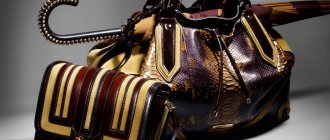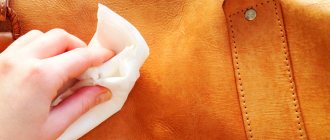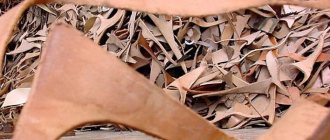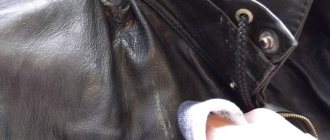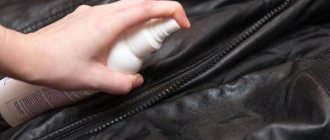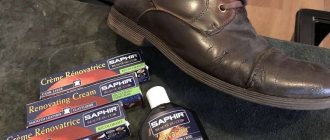Look at the internal and external coating
You should take a close look at the texture of the accessory.
If you distinguish the pores, notice their symmetrical arrangement - most likely, you have a substitute in front of you. Natural raw materials have only random porosity and slightly noticeable wrinkles. The relief is harmonious, but not uniform. Hold a piece of cloth with your palm. Natural fabric will absorb moisture and quickly warm up, taking on your body temperature. Artificial fibers, on the contrary, repel sweat and leave a feeling of moisture on your hands. Squeeze the piece of paper with your fingers – there will be no creases or dents left on the real one.
According to processing methods and coloring, genuine leather is divided into:
- Nappa is a processed cattle breed characterized by softness, elasticity and even color. One of the most durable and most affordable types of natural textiles.
- Morocco is the name given to goat skins that can be tanned, lightly burned, and brightly dyed. More often it is used for the production of boots and bindings.
- Velor – chrome-tanned leather, finished like soft velvet on the side of the lining, through special grinding.
- Suede is the skin of non-large horned animals, characterized by a thick but not fluffy pile without shine, softness and pleasantness to the touch. Its front side is bakhtarmyanaya.
- Shagreen is a soft, vegetable-tanned skin that comes from sheep or goats. The surface of the products is distinguished by a beautiful and fine pattern with a relief texture.
- Laika is a product obtained by tanning with aluminum alum using salt, flour and yolk. The raw materials used are the skins of sheep, goats and dogs. The material is soft and very thin. This is what gloves are most often made from.
- Nubuck is a common material, a finely fleecy fabric, characterized by velvety and softness, obtained from a cow or calf. Visually and to the touch it is very similar to suede.
- Lacquer – a finish coated with a special varnish on top. Accessories made from it can only be worn at temperatures from −10 to +25 degrees and only in the absence of precipitation. Usually, spring ballet shoes, wallets, and inserts on clothes are made from it.
The best quality and comfortable bags made of genuine leather are sold by Piquadro. It has established itself as a reliable supplier of branded goods in the domestic market.
Checking at home
If you have a leather product at home and want to check its originality, you can do this using an extreme test. Water and fire will help with this.
More details on how to carry out a test at home will be discussed below. Try to carry out the procedure carefully so as not to damage the item.
How to test with fire?
If you have clothes or shoes made of non-genuine leather, if you bring fire to the product, the fabric will melt. You won't see any fire. Black smoke with a pungent odor will be produced. After such a check, the product will have an unpresentable appearance, as a deformation process will occur.
Genuine leather can withstand high temperatures, up to +130°C. Therefore, it is often used in the production of suits for firefighters.
How to test using water?
Lay out the product and drop a little water on it. If the fabric absorbs moisture, it means the clothes are made of genuine leather. Leatherette does not absorb moisture.
Unfortunately, this method cannot be used to test shoes. This is due to the fact that it is coated with a special impregnation so that moisture and dirt remain on the surface. If you pour water on your shoes, the moisture remains on top.
Now you know how to distinguish leather from leatherette. This can be done not only at home, but also in the store. The main thing is to carefully examine the product to understand what kind of leather the shoes or clothes are made from. This can be done by the depth and location of the pores, by the quality of the cut, or by the wrong side. At home, the test can be carried out using water and fire.
Look at the condition of the edges and seams
The best way to check and determine whether the leather in front of you is real or not is to study its surface and material from the inside. The inspection should begin from the inside out. Unfortunately, you cannot see it in all products. You can actually examine the structure by finding a section of tissue. Real leather is made from suede fibers, while leatherette is most often made from synthetics. Now another analogue is gaining popularity - eco-leather. And in terms of external characteristics, it is completely indistinguishable from natural, but its artificial origin is immediately revealed by the fabric lining.
There should be no threads sticking out of the stitched seam, the raw material itself does not delaminate, the reverse side is rough to the touch, fleecy, looks like suede, sometimes not finished dyeing. The paint in artificial fibers is absorbed much better, so the color is always bright and rich, unlike natural ones.
In order to check the quality of dyeing, you need to take a small piece of white cloth and moisten it in water. If you wipe the surface of an accessory with it and it does not stain, the item is made to last. However, there are very few such products on the modern market. Therefore, when purchasing even an expensive product, it is better to periodically treat it with water and dirt-repellent agents. They will help not only protect the outer material, but also ensure the durability of the shades. Otherwise, your brown bag may turn yellow over time.
Natural things are much more expensive, not only because they are of animal origin. Working with such a base is much more difficult. The skin is thicker and denser than its substitutes, and sewing elements together is not as easy as fabric ones. The edge of the craft is even and smooth, which cannot be the case on a leather cut. Expensive and high-quality products should have an even cut, without missed stitches and without traces of glue.
Differentiation methods not used in the store
If after a visual inspection there are still doubts, you can test the product with water and flame. You are unlikely to be allowed to carry out such experiments with skin in a store. Experiments with heat and water are most often carried out at home.
Reaction to water
If you drop a little water on genuine leather and it is gradually absorbed, then it is not a fake. Water drains from leatherette and leaves a dry surface and a white mark behind. Even if you completely wet the leatherette, only its lining will absorb water. Water will drain from the outside without penetrating inside.
Wet items made of genuine leather can be ironed with a warm iron without steam through a gauze cloth. In this way, small creases from the skin are removed.
Reference!
Genuine leather should not be dried on a radiator or with a hot iron. After drying, it will change its size downward and lose its appearance.
Experience with fire
If you take a small sample of leather and bring it to the flame, the result will immediately allow you to distinguish a fake from a natural product. The leatherette immediately melts, and the leather gradually begins to deform, shrink and emit the smell of burnt hair.
Pay attention to the label
Natural shoes are always equipped with a small sticker with several symbols, which usually provides comprehensive information about the upper and lower parts of the accessory and the composition of the lining. A piece of the material from which it is made is also hung on a high-quality bag: in the form of a diamond for leatherette and irregularly shaped for leather goods. On a small section, the following lines are written, which will indicate how to identify genuine leather from a fake:
- genuine leather (in English);
- vera pelle (in Italian);
- cuir (in French);
- echtleder (in German).
However, even if the purchased product has a sample of the material used attached, this does not mean that the product is leather. This small section also needs to be verified for authenticity by any available means.
In order not to be deceived, natural things should be purchased only from trusted companies, at specialized points of sale. At bazaars, spontaneous markets or just on the street, you are not immune from counterfeiting. Upon request, you must be provided with a quality certificate and a guarantee for the product. The document must indicate the material from which the accessory is made, and be stamped and signed by a representative of the body issuing the certificate.
What can you do in a store to distinguish products?
There are certain methods that are usually used in stores and markets. If it was not possible to recognize leatherette using the above methods, and doubts remain, you can try the following manipulations:
- Warm it by hand and check the heat transfer.
Place your hand on the material. If it quickly feels warm and does not become moisturized, then you have real skin. Leatherette takes a long time to heat up and become moisturized, that is, it does not allow heat to pass through. - Pay attention to the smell.
If the manufacturer has not taken care and has not scented the artificial leather, it can be given off by a pungent odor of the chemicals used to process the product. Natural material has its own specific pleasant smell. - Examine the label (shape, inscription), check the presence and shape of the tag.
On things that are made in a factory, manufacturers usually designate the material with a label with a special symbol or inscription. Leather is usually designated on a small piece of the product with the mark: “genuine leather”, natural leather, etc. Leatherette is usually indicated by a diamond icon or the word "Leather".
Important!
Leatherette is any product that has been subjected to chemical treatment. That is, even if the animal’s skin has been treated with chemical solvents, it cannot be considered natural.
Price
Leather products cannot be cheap - this is the main rule that must be followed if you do not know how to determine the naturalness of leather. However, it all depends on which animal’s skin was taken as a basis.
- Budget jackets, shoes and linings are made from pork.
- Made from bull, hard and durable - various accessories: belts, bags and backpacks.
- From cowhide - items in the middle price segments, mainly shoes.
- Calf leather - handbags, clutches, shoes and jackets.
- From sheep - gloves, bags, belts and luxury outerwear.
- Expensive wallets, gloves, and men's wallets and purses are made from the delicate skin of goats.
- Premium products are made from the skins of exotic animals. These are jackets, raincoats, luxury shoes, bags and shoes made of crocodile, ostrich, and deer.
Another expensive material is patent leather. To obtain it, the canvas blank is primed and varnished on top, after which a spectacular glossy sheen appears. The advantage of such an acquisition is the variety of color palettes. Cover the surface with matte or glossy varnish. Lacquered raw materials are used to make bags, wallets, belts, and various inserts on clothes and shoes. But such accessories require special care. If the slightest scratch appears, things will look unkempt.
General tips for determining the quality of boots
Remember that leather boots will be slightly more expensive than substitute boots. The exception is some shoe brands that mainly produce lines of shoes made from substitutes and they cost the same as natural ones (Mustang, Marco Tozzi).
An important factor in determining the naturalness of materials is the porosity of the leather. If you look closely, the peculiar pattern on the skin is somewhat unique and uneven. It is thanks to these pores that the material breathes.
The leather is heavier and thicker than the substitute. Because of this, against the background of the same pair from a substitute, it may look somewhat more massive and rougher. Leather boots will not be light in weight (unless they are a designer model). Take a closer look at the fittings and lining. If the inside is sewn with a lining, then pay attention to that too. A quality product has the same lining.
As you can see, there is no need to make hasty purchases, but just take a good look and feel the product.
How to check leather for authenticity: evaluate the smell of the product
Things made from low-quality leatherette generally emit a sharp and unpleasant aroma of chemical elements, reminiscent of plastic or oilcloth. It dissipates very slowly. Every person has encountered such an amber at least once when purchasing budget shoes. High-quality leather accessories have a subtle aroma.
It is worth understanding that, just like tags, unscrupulous manufacturers and sellers also fake the smell by sprinkling accessories with appropriate flavors or adding them to the raw materials at the manufacturing stage. However, the sharp chemical aroma of cheap analogues cannot be masked by anything.
Advantages of genuine leather products
- Products made from genuine leather look much better and more solid than those made from leatherette. In addition, they are durable and practically do not wear out during long-term wear.
- Genuine leather is highly durable. For example, a travel suitcase made of leatherette may burst if you put too many things in it. This will not happen with natural material.
- Products made from genuine leather are resistant to the environment. They are not afraid of temperature changes, wind, cold, snow and rain.
- Easy to care for. Dark items made from dermantine can be cleaned just as well as those made from genuine leather. The same cannot be said about light ones. For example, a beige leather bag will retain its natural color. It is enough to wipe it with a sponge in soapy water. And the surface made of light dermantine will absorb dust and dirt, and after a while it will change color.
In terms of its qualities, genuine leather is significantly superior to leatherette. Therefore, before purchasing new things, be sure to take this into account.
Try testing the product with fire
Many people wonder whether genuine leather burns or not, because you don’t want to spoil a new product, just out of curiosity whether it’s real or not. And store sellers do not allow you to do such experiments before you have paid for the goods. But if you are sure of the origin of the purchase and want to prove its authenticity, you should not be afraid of fire. Under its influence, leatherette will immediately begin to melt, emitting smoke and a pungent odor. Sometimes the entire product flares up due to the fact that manufacturers treated it with special aniline mixtures. The natural material is not afraid of flame and emits a perceptible smell of spruce. If you don’t know how to quickly test leather for naturalness with fire, use a regular lighter or matches.
Question? Answer!
Q: Can a royal blue bag be made of genuine leather?
Oh yes of course. Natural leather today is dyed in almost any color, from hot pink to fluorescent blue. Therefore, it is likely that such a bag is made of 100% leather. In order to be completely confident in its naturalness, use the tips given above.
Q: What should I do if there is a hole in my leather jacket?
A: If a rupture appears on a genuine leather product, we recommend that you contact a repair shop. If this is not possible, then use liquid skin. In order for the restored area to be identical to the original appearance, it is necessary to carry out the procedure 2-3 times. Repairing a small tear using this method is quite easy, and it will turn out unnoticeable. However, this method can only be used on smooth skin. It is not suitable for suede, nubuck or patent leather.
Testing with water
Another way is to drip a few drops of liquid onto the surface. Natural matter will immediately absorb it, leaving a characteristic dark spot. Synthetic analogues will repel it, but the color of the surface will not change in any way. But you shouldn’t rely too much on this method. Modern things, especially expensive ones, have long been treated with water-repellent mixtures in order to increase wear resistance and ease of use.
Differences between genuine and pressed leather
Pressed leather is very similar in appearance to natural leather. This is a soft, elastic, durable and evenly colored material that is made from natural leather waste. Due to this, the products are much cheaper than genuine materials.
In the production of pressed material, leather scraps and scraps are used, as well as synthetic fibers for bonding and strength. First, the waste is processed and turned into granules, after which it is mixed with artificial additives and pressed. The resulting fabric is dried and passed through the press again. After cooling, the skin is dyed, and the result is a durable, elastic and strong material.
Despite its aesthetics, apparent strength, reliability and durability, pressed leather has a much shorter service life than natural leather. It cracks and wears out, wrinkles and deforms, stretches or, conversely, shrinks.
The pressing allows moisture to pass through, but does not allow air to pass through, and is easily torn and broken. In shoes made of such materials, your feet constantly sweat. Jackets, bags and other things will quickly wear out and crack, and may tear at the seams. Therefore, it is important to distinguish between genuine leather and pressed leather. To do this, use the methods described above.
Special attention should be paid to suede
It is suede products that can most often be found on the market after ordinary leather ones. Often, several types of leather are combined in bags, shoes, wallets and clothing. Suede or varnish pieces are inserted. Chamois is the raw skins of deer, elk, sheep and young calves, richly soaked in fat. It is counterfeited using several methods: woven and non-woven. The first is special processing of microfiber threads under production conditions. The second is the usual gluing of pile on top of a textile flap. To distinguish suede from a fake, you need to:
- Estimate the cost. Suede products cannot be cheap. They are not for the wallet of a budget buyer, even with the maximum discount.
- Take the accessory in your palm and feel it. Natural matter quickly heats up and takes on the temperature of your body, and itself begins to radiate heat. Pseudo-suede will remain cold.
- The pile can be “combed” in any direction with the palm of your hand. The shade of the surface will change. The counterfeit hairs do not react to such manipulations and their color will remain the same.
- If the item is uniform in tone and texture, you are probably getting a fake. Natural suede will always have microdamages, scratches and cracks.
- The leather is elastic; if you bend it in half, a trace of a crease will appear, which quickly disappears, and the surface will return to its original appearance. With a fake it will be different - either the trace will not go anywhere, or it will not form at all.
The main differences between genuine leather and artificial leather
So, you have decided to buy an Italian bag made of genuine leather in an online store. We will omit all the details about exactly how to choose an online store and how to understand whether you are really buying Cromia, Braccialini or Di Gregorio (we have already written about this). Today we will focus on the material.
Sign No. 1. Attached piece of skin
Every leather goods manufacturer always attaches a small piece of leather to the bag, from which the handbag is made.
Such a label guarantees that the item is truly of high quality. Branded products are often marked in a special way: if it is a symbol of animal skin, it is real leather. The diamond icon symbolizes that the item is made of leatherette, the linen symbol means the bag is made of textiles.
You can be sure that the bag is made of natural material if you see inscriptions such as “vera pelle” or “genuine leather”, which means “genuine leather” in Italian and English, respectively.
Sign No. 2. Cutting material.
Another “sign” by which one can determine the “naturalness” of a material is its seamy side. Of course, you won’t find the inside out in well-made handbags. But if you suddenly find a cut (perhaps in those places where a zipper or trim is sewn), keep in mind that the bakhtarma (as the back surface of natural leather is called) should be soft and feel like suede. At the same time, the reverse side of leatherette products is covered with textiles.
Also note that the cut of a leather bag will be different from that of a leatherette product; it will have the shape of a fluffy, round roller. Artificial materials have a completely flat cut.
Ask the online store seller to send you a photo of the inside of the bag and its cut.
Sign No. 3. Appearance of the bag.
No matter how obvious it may be, its appearance will say a lot about the material from which the handbag is made. The front side of genuine leather (it is called merey) should not contain cracks, wrinkles and creases. In addition, you should check the quality of the dyeing of your handbag. Scratch the product lightly - the surface should not delaminate and the paint should not chip off.
The paint should not remain on your hands after you have touched the product - this is a clear sign of low quality.
The coloring should be uniform, without stains, various sagging and other defects. Unlike artificial materials, leather itself is very plastic. Therefore, if a thing, for example, a bag made of genuine leather, is slightly stretched, it will immediately return to its previous state. Leatherette does not have this property, since no analogues to natural collagen have yet been found in modern production.
Sign No. 4. Genuine leather absorbs moisture, but artificial leather does not.
Another way to check “naturalness” is to slightly wet the bag.
Real leather absorbs water and darkens as it does so. Artificial materials do not absorb moisture and water rolls off them.
It's easy to check at home. The main thing is not to overdo it: you don’t need to hold the bag under the tap. Wet the accessory strap a little and wait. If the skin is thick, rub in water for a couple of minutes. This will be more than enough for the test.
Sign No. 5. Hot - cold
Did you know that genuine leather conducts heat well? This means we have another reliable way to check the material. To conduct this experiment, just hold your hand on a piece of real leather - it will quickly heat up, and you will feel it.
But leatherette has a low heat transfer coefficient, so a handbag made from it will remain cold.
Sign No. 6. Fire testing
The last method, of course, is not easy, but it is no less effective.
When you set fire to a piece of leather, you should smell the burning natural material, not chemical compounds.
Of course, it is unlikely that you will be able to set fire to a bag right in the store (especially if it is an online store), but if you manage to cut a small piece from the tag, you can check it at home.
Armed with these tips, you can easily distinguish even the most skillful fake from the original. But, of course, the surest way is to buy accessories in the trusted online store “Northern Venice”.
We are pleased to present you only high-quality bags made of genuine leather from Italian brands. And, of course, we do not sell fakes or Chinese fakes. Each handbag is presented in a single copy and purchased directly from the brand's design houses.
If you know any other ways that will help distinguish artificial leather from natural leather, share with us in the comments!
Happy shopping!
Nowadays, it has become difficult to distinguish natural high-quality leather from artificial leather, because the technology for manufacturing artificial materials has reached a very high level. Dishonest manufacturers manage to add residues of natural material to the composition, which gives the leatherette the characteristic smell of natural material. Various tricks are used, and in the store, when asked if the bag is leather, they will definitely answer you - yes, of course! In this case, the product may be obviously of poor quality, but the seller will stand his ground to the last.
A mistake when purchasing is always unpleasant. To avoid wasted money and a bad mood, it is worth learning some signs that will help you distinguish genuine leather from a fake.
Some tips on how to check and determine whether leather is genuine or not
- Try not to buy leather products on the market, even if they convince you of the quality of the product and demonstrate checks in all the ways described above. Subsequently, the accessory will turn out to be rough, the seams will fall apart and the surface will fade after a short period of wear. Give preference to branded places of sale with a good reputation.
- Find out what animal the skin belongs to, especially if you are choosing clothes. Buffalo, calf or bull dressing is durable and will last 10 years, while pork is more affordable, but also has the ability to stretch and has a service life of 3-5 years.
- Pay attention to the country of origin. The best goods were brought from Italy and England. Sweden, Germany and France.
- Check the thickness - it should be identical over the entire surface or reinforced in the places where the zipper, armhole is inserted or handles are sewn on.
In the article we told you how to find out and understand whether leather is genuine or not. If you carefully examine the surface, look inside, at the seams and joints, and also remember all the recommendations of experts, you will definitely be able to distinguish a fake. The more ways you try, the more likely you are to find out the truth.
Properties and types of genuine leather
Genuine leather comes in different types and varies in thickness, resistance to wear, breathability and other similar parameters. There are three main methods of leather processing. Raw leather is a skin that, after certain procedures, is first soft and elastic, and after drying, hardens. This is a suitable solution for covering various objects, including drums and other similar musical instruments.
A common type is tanned leather, which is a strong and durable, plastic and elastic, soft material. In addition, it is resistant to moisture, heat and cold, and temperature changes. Raw meat is used for orthopedic shoes, horse saddles, bicycles, motorcycles and other items. The result is a durable, reliable and rigid material.
